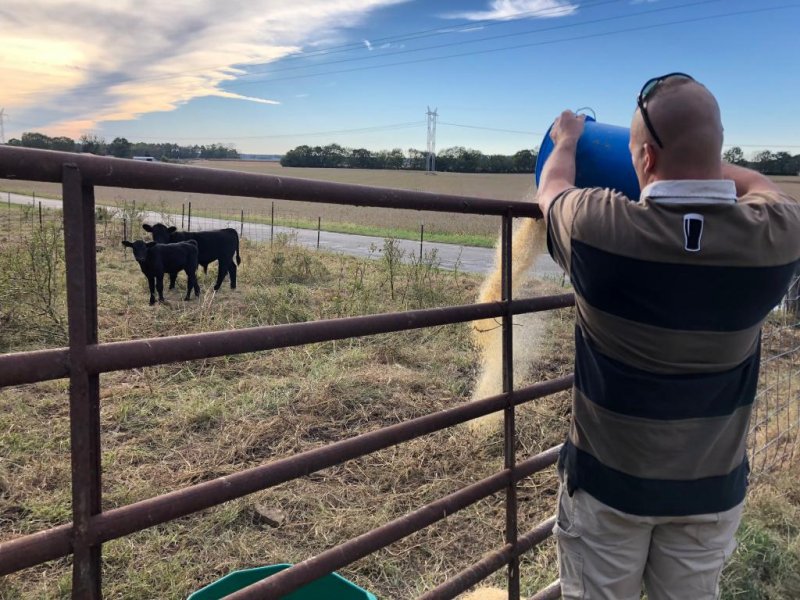1 of 8 | Elias Donker, a retired Army major, feeds the calves on his small farm near Terre Haute, Ind. Photo by Jessie Higgins/UPI
TERRE HAUTE, Ind., Oct. 18 (UPI) -- As the number of working farms declines in the United States, government and industry leaders are turning to a new place to find new farmers -- the military.
In the last decade, the U.S. Department of Agriculture has poured millions of dollars into programs to help military veterans begin farming. From that funding has sprung hundreds of new organizations, grants and training programs across the country.
The primary motive is America needs farmers.
Today, there are just over 2 million farms in United States, less than a third of the number a century ago, according to the USDA. Much of that decline is due to technological advances that enabled farmers to do more work with less manpower. But in recent years a startling new trend has emerged: Farmers are getting older, and there are few young people standing by to take their place.
The average age of the American farmer is now 58, and more than 60 percent of farm owners are over 65.
"We have a crisis in agriculture," said Michael O'Gorman, founder and director of the Farmer Veteran Coaltion. "This is the first time in history we really need new farmers."
O'Gorman, a lifelong farmer who is now 70, stumbled into the issue in the early 2000s. After a successful 40-year career in agriculture, he wanted to give back. So in 2007 he brought together a group of farmers to discuss offering jobs to veterans. At that time, there were few organizations connecting veterans to farming, O'Gorman said. He had a hunch it would be a good fit.
That hunch turned out to be so correct that within a decade it was a national movement.
Veterans, O'Gorman discovered, are uniquely qualified to farm. Their training has made them task oriented, they are accustomed to long hours and hard labor, and adapt to overcome unforeseen obstacles -- all pillars of farm life.
"There's a lot of skills we learn in the military that transfer," said Cindy Chastain, the veteran outreach coordinator for the National AgrAbility Project. "Farming is a mission."
What makes the match even more promising is that farming is also good for veterans, especially those who return with certain disabilities or PTSD. They can find healing in growing plants and tending animals.
"In my free time in Iraq, I built a farm in my head," said Elias Donker, a retired Army major who owns a small farm in Indiana. "That was my happy place. I told myself, 'If I live through today, when I get home, this is what I'll have.'"
Donker was seriously injured during his tours in Iraq from IED and car bomb explosions, and he medically retired in 2012. At just 32, his body was too broken to work, so he and his wife and young daughter returned to their home in southern Indiana, where they found a nine-acre plot with an old farmhouse.
"Places like this don't just happen," Donker said, sitting at his kitchen table Tuesday afternoon. "Before we even got here, God paved the way."
In the early days, Donker worked when he could. A traumatic brain injury made it hard for him to remember tasks. He struggled with manual labor, due to neck and arm injuries. But the more work he did, the quicker he healed. And within a few years, his body and mind recovered, and he had a robust, working farm.
"I could have spent the rest of my life on [pain medication] and high out of my mind and not cared. But I'd rather be doing this," he said, grinning.
His farm is small and sustainable. He sells organic, grass-fed beef cattle to people from nearby cities. Donker's wife, Sara, tends chickens and grows a garden. They sell eggs to their neighbors and vegetables from a stand at the end of the road. They keep pigs in the woods behind their house. There's little money in them, Donker said, but they feed his family.
Like many new veteran farmers, the Donkers had no farming experience. They connected with Chastain, at AgrAbility, took a few Purdue University new farmer training courses and spent a lot of time talking with the elderly farmers in the area.
It was not easy.
"Veterans face a lot of challenges getting into farming," Chastain said. "Getting the funds to buy the property and the equipment they might need is a big one, and also training. Most veteran farmers grew up in rural communities, but they may not have ever worked on a farm."
This was one of the first things O'Gorman discovered as he built his coalition.
"In this all-volunteer military, unfortunately, many of the volunteers are coming from rural communities," O'Gorman said. "There are not a lot of organizations to serve them."
As the Veteran Farmer Coalition grew, O'Gorman and the other members asked lawmakers for support. The USDA had recognized the need to attract young people to agriculture and was spending millions on programs devoted to that purpose. In the 2014 farm bill, Congress added millions in programs specifically aimed at veterans.
Since then, the number of organizations that help veteran farmers exploded to more than 250, O'Gorman said. He estimates there are now around 30,000 veteran farmers across the country.
"On the one hand, it's a crisis; on the other hand, it's an opportunity," O'Gorman said. "There are so many organizations helping veterans, and there is demand for locally grown produce that wasn't there years ago. It's possible now for a veteran to get 10-15 acres that were overlooked by other farmers, and they can do well."















